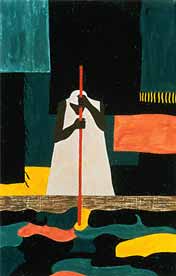|
|
 |
 |
 |

Click here to view a larger image |
The female
worker was also one of the last groups to leave the South.
The Migration of the Negro, panel
57, 1940-41. Casein tempera on hardboard, 18 x 12 in. (45.7 x 30.5
cm). The Phillips Collection, Washington, D.C.
Artwork © Gwendolyn Knight Lawrence, courtesy of the Jacob and
Gwendolyn Lawrence Foundation |
| |
|
 |
Southern black women
were excluded from virtually all areas of employment except domestic
service. As domestics, they worked long hours away from home, cleaning
other people’s houses, washing their clothes, and caring for
their children. For this labor they were paid the lowest of wages.
One black woman recalled that her employer paid her only ten dollars
a month, yet forced her to sleep in the house where she worked, and
allowed her to go home only once every two weeks for an afternoon
visit.1
Although there is evidence that many black women wanted to migrate
north, these women, whether single or married, often did not have
the financial means to pursue their goal. Husbands frequently traveled
ahead of the family while their wives remained, and worked, in the
South until there was enough money for the whole family to migrate.
Because women were paid so little, it took them much longer to save
enough money for migration.
In this image, Lawrence portrayed a woman engaged in her work at a
commercial laundry. She is washing clothes. Rugs and blankets hang
behind her. The red handle of the woman's washing stick creates the
painting's focal point and divides the composition down the center.
1. Carole Marks, Farewell–We're Good
and Gone: The Great Black Migration (Bloomington, Indiana: Indiana
University Press, 1989), p. 145. |
|
|

• Imagine that you had the opportunity to
interview the woman in this painting. What would you ask her?
What do you think she would tell you about her life?
Write down your imaginary interview. |









